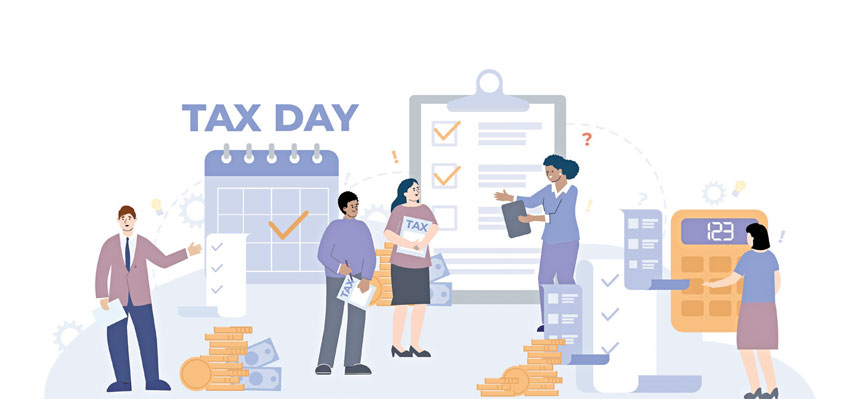Making Taxing Less-Taxing!

Tax laws in India are notoriously complex and convoluted. The new Income Tax Bill 2025 is an attempt to make them more simple and precise, cut out the jargon and straighten out the intricate labyrinths, consolidate many a scattered tax provision, and pare down redundant laws. Expected to come into implementation as an Act by April 2026, the exercise seeks to literally halve the document, in length, bulk, and density, in a bid to bring in a simple, easy to understand, people-friendly law
The Income Tax Bill 2025 has been tabled in the Lok Sabha. It has gone to a Select Committee and a report is expected shortly. Thereafter, the updated Bill will be tabled again and after discussion, the Bill will be passed. Presumably, Income Tax Act 2025 will be operative with effect from 1 April, 2026. The 31-member Select Committee constituted for this purpose is headed by Lok Sabha MP Baijayant Panda of the BJP.
The new Bill is more about consolidation of scattered tax provisions, simplification, and elimination of redundant laws, than about rate or structural changes. The Income Tax Act hitherto has been infested with jargons-centric provisions and it is quite bulky. There are sections coupled with sub-sections, sub-clauses and provisos. To explain the sections, there are explanations at many places and again there are explanations to explanations. To illustrate, there is the sub-section 10(23c), which runs into many pages with a plethora of sub-sections to sub-sections, clauses, provisos and explanations, with regard to laws relating to public charitable trusts like colleges, universities and hospitals.
The noted tax law advocate Late Nana Palkhivala, in the preface to his book on Income Tax had said, “The Indian Income-Tax Act is the most cumbersome legislation on Earth.” The Bill introduced is an honest and bold step to make the law simple and precise. The Bill has a total of 2.6 lakh words used, as against 5.2 lakh words in the previous Act.
History of Income Tax in India

The origins of Income Tax in India can be traced to ancient India. The famous economist of India, Kautilya, had spoken about income tax in his book, where he explained how tax from income should be collected by the king from his subjects. It should be like bees gathering honey from flowers with no harm being caused to the flowers. Such a thing about ‘bees and flowers’ has also been said by sage Vyas in the Mahabharata. In modern times, income tax was first introduced in 1860 by Sir James Wilson in order to meet the losses caused by the first war of Indian independence of 1857. With changes, the laws enacted continued till the Income Tax Act of 1922.
The next halt was Income Tax Act, 1961, which is continuing till today, with a mushrooming of amendments every year during the Budget announcements, and sometimes in between. Many a times, the amendments were required to plug the loopholes in the legislation being used for tax avoidance or tax-evasions. The Income Tax Actwas not the only one to be administered by income tax officers, as it came along with its siblings, like Wealth tax, Gift tax and Estate Duty. All the siblings now stand removed, as at one time some tax-payers paid more tax than their earnings.
Highlights of the Income-Tax Bill:
- The main feature of the Bill is simple language and shorter sentences. For illustration, the present Act is filled with the use of the word ‘notwithstanding’, and the same has been completely removed and replaced with a simpler word, ‘irrespective’.
- One notable change in the Bill is the introduction of the term ‘tax year’, which refers to the 12-month period starting from 1st April. This replaces the existing terms of ‘assessment year’ and ‘previous year’.
- The Bill also removes outdated provisions such as those concerning Fringe Benefits Tax. By eliminating redundant explanations and provisos, the new Bill aims to enhance readability and comprehension.
- There are no major tax or structural changes. The intent is to make laws easier to understand.
- Presently there are various provisions relating to tax deduction at source (TDS), where different rates and thresholds have been provided, depending on the nature of payment or status of payees. The Bill proposes to comprehensively overhaul the structure by consolidating them into a single section (except for TDS on salary), where all TDS provisions are to be categorised into three broad heads:
- TDS on payments to residents
- TDS on payments to non-residents
- TDS on payments to any person (residents, non-residents or both).
For each category, TDS provisions have been consolidated into a single table for ease of identification of applicable rates and nature of payments, on which TDS will be payable with threshold limits.
- Tax in special cases, minimum alternate tax, and tax of shipping companies have been combined into one chapter.
- Certain provisions relating to tax exempt incomes, including the existing Section 10, have been moved into six different schedules.
- Most of the amendments proposed by the Finance Bill 2025 have been incorporated in the new Bill.
- Many provisions in the Bill will require specific rules to be prescribed, which are likely to be released separately.
- Except for a few clarificatory modifications to the language, the transfer pricing framework remains the same.
- Additional guidance is given for complex residential status cases.
- It is expanded to address modern income streams like virtual assets and online activities.
- Standard deduction from salary increased to Rs 75,000 with conditions.
- Reopened assessments, stricter timelines and codified procedures, though law remains the same.
- With a reduction in the content, the Bill aims to make compliance easier. This in turn will encourage more tax filings and reduced tax evasion. The Bill, as a result, aims to reduce legal disputes.
- The Bill introduces a unified term ‘Non-Profit Organisation’, replacing varied terms like Trust, Institution, University, Hospital, etc. Existing registered NPOs do not need to go for fresh registration. All provisions related to NPOs have been segregated into one chapter.
- The concept of ‘virtual digital space’ has been introduced in the definition of computer systems covering e-mail services, social media accounts, remote servers, cloud servers, digital application platforms, etc.
- The Bill marks a significant step in reforming, modernising and simplifying the IncomeTax framework.
For developing our country, we want more tax revenues and for this we need a wider tax base. We have to make ‘Viksit Bharat’ by 2047 and for this the new Tax Bill is a good step
Comments:
1. The number of income-tax returns filed in FY 2023-34 was 8.09 crores. In the previous year, the number was 7.40 crores. However, the number of actual tax payers was around 1.5 crores. Now that rebate has been given up to an income of Rs 12 lakhs under the 2025 Budget, the number of actual taxpayers will further fall from the coming year, and it may not be more than one crore. For such a modest base of actual contributors of tax, it is not desirable to have complicated legislation. On the contrary, these contributors should be welcomed by a simple tax system and simpler compliancemechanism. The new Bill is a welcome step in this direction. Tax paying people will like this and it will also minimise unwelcome litigation.
2. Tax law full of jargon is simply not readable, and is also one of the causes of tax evasion and tax-avoidance. Tax-payers supported by big tax consultants, fish out loopholes in the legislation to understate income. It does not only stop here, black money goes out of the country into tax-havens and comes back to the country after round-tripping.
3. As of March 2022, more than Rs 10.4 lakh crores were blocked under direct litigation. In terms of pending tax cases, 5.6 lakh direct tax cases were pending at various levels (80% cases before CIT(A)). Many of the disputes arose due to non-clarity of the provisions. It is believed and rightly so, that unnecessary blocking of taxrevenues will drastically go down with simpler provisions in the new Bill.
4. For a population of about 140 crores, the actual contributors of tax of about one crore in the coming years will be too narrow a base. The intent of the bill is to attract more people in the tax-base. It is realistic to think that with simple readable laws and simpler procedures, more people would like to pay tax and buy peace for themselves. For developing our country, we want more tax revenues and for this we need a wider tax base. We have to make ‘Viksit Bharat’ by 2047 and for this the new Tax Bill is a good step.
5. The simplified Income-Tax Act after replacing the old IPC, CrPC and Evidence Act, will work as a trigger for amending more old Ads. Simpler laws will encourage compliance with the rule of law and will improve ease of doing business.
6. One big stumbling block in the progress of our country is our slow judicial process. Our laws are archaic. In many cases, the precious time of the courts is wasted in interpreting the meaning of the words in the provision and not on real justice-delivery. Following the simplification of complicated income-tax laws, other laws too will get simplified and this will help our judicial process. Today, roughly five crore cases are pending before the courts. Simplification of laws will help us there.
In conclusion:
Let us remember what the great scientist Albert Einstein said “The hardest thing in the world is to understand the Income-Tax Act.” The Indian Income-tax is much more complicated than what even Einstein experienced in the United States of America. The new Bill, now tabled, will solve this problem of incomprehensibility and complexity.